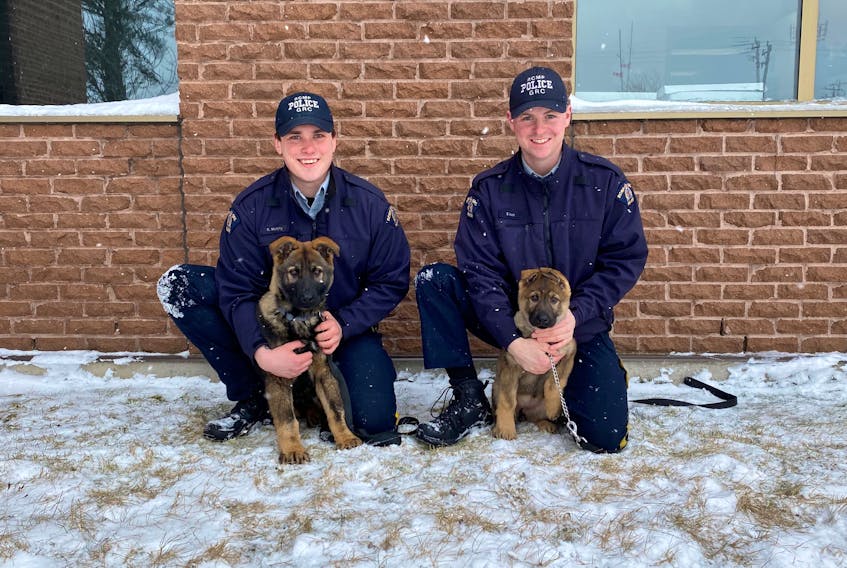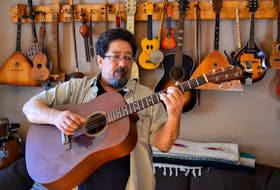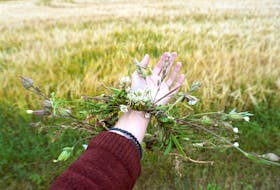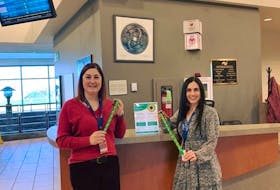STEPHENVILLE, N.L. — Constables Braedon Rose and Colin Murphy know first-hand that work partners don’t always have to be human. And that makes them very happy.
Rose and Murphy are RCMP officers at the Bay St. George detachment in Stephenville. Under the supervision of Cpl. Fraser McInnis, a certified dog handler, they are going through the imprinting process to become RCMP dog handlers as well.
As part of their training, they work with their own pups, training them with the hope they can someday soon become police service dogs.
First, they had to show their dedication to the program, volunteering to work with other handlers and dogs around the province. Then they qualified for their imprinting course in Innisfail, Alberta which they successfully completed last fall. Upon returning to the detachment, they started imprinting the dogs, designated as potential police service dogs.
Murphy got his dog, Neon, on Dec. 16. Neon is five months old.
Rose’s dog, Nattie, is even more of a newcomer. The 12-week-old pup came to Stephenville on Jan. 20.
Like all police service dogs, Neon and Nattie are German shepherds. They are bred from a long line of dogs in Innisville and they live with their respective imprinters.
Murphy and Rose will train the dogs to run on ice, walk around traffic, be around crowds, jump on things, follow commands and complete other relevant tasks.
“They (have) to be used to all those different types of areas, surfaces and environments that we operate in,” stressed McInnis.
He adds most of the imprinting is informal and more about “opening the dog’s eyes to the world.”
Wanting to work with dogs
Both Murphy and Rose were inspired to take on this challenge as lovers of dogs.
Rose says he grew up next door to an RCMP dog handler. Speaking with his neighbour over the years and seeing how much fun he had at work with his dog created Rose’s interest in the program. When he joined the Bay St. George RCMP in 2019, McInnis continued to guide him in that direction.
For Murphy, growing up he wanted to go into law enforcement and always had a love for dogs.
He says it wasn’t something he thought about doing until entering the Bay St. George RCMP.
As he started talking to McInnis and working with McInnis’ dog, he decided it was something he really wanted to do.
“It’s the most exciting part of the police work that we do; when we get to work with the dog,” said Murphy.
Training and bonding
Early on, one thing Murphy and Rose are learning is the importance of being patient and getting to know the dogs and their personalities.
Nattie’s energetic disposition, a potential product of her age, means training her presents some different challenges from the more laid-back Neon.
“The way I work with Neon is going to be completely different than if I had a dog like Nattie, who is a little bit higher energy,” said Murphy. “Neon will do whatever you ask him to, for the most part, without making a noise and just for a little bit of kibble or his Kong.”
“Nattie requires a lot of energy and a lot of feedback to motivate her through things,” Rose added.
As imprinters, Murphy and Rose are working to familiarize the dogs to as many situations as possible. Everything, says Murphy, is essentially designed as a game for the canines to make all their tasks as fun as possible.
Growing the dog’s confidence and having them believe in themselves and trust in their handler is a big part of the process. Murphy stressed persistence is also important.
For example, a big hurdle that Nattie recently overcame was the simple task of walking down a flight of stairs.
“She’s still so small. I think she was a little apprehensive about tumbling down the stairs,” added Rose.
They returned to that flight of stairs repeatedly for two weeks before Nattie overcame her fears and made her way down. Seeing the dogs complete these tasks, through persistence, is very rewarding to their imprinters.
When the imprinting is done – usually when the dogs are between one and 1.5 years old – the imprinters will have to say goodbye to their canine friends. Murphy and Rose figure it won’t be easy, given how much of a bond they are developing with the animals.
The dogs will be brought to the Alberta training centre to determine whether they qualify to be service dogs. If they pass, they will then be allocated to their own permanent dog handler, potentially anywhere in Canada.
Meanwhile, Murphy and Rose will be given new dogs to imprint. They both plan to stick with the program. It will take between five to seven years before they can qualify as dog handlers.
“It’s definitely a lot of responsibility but I’d do it for years and years,” said Rose. “When we’re out working with those dogs, we’re having the best time. It’s my favourite part of every day.”









